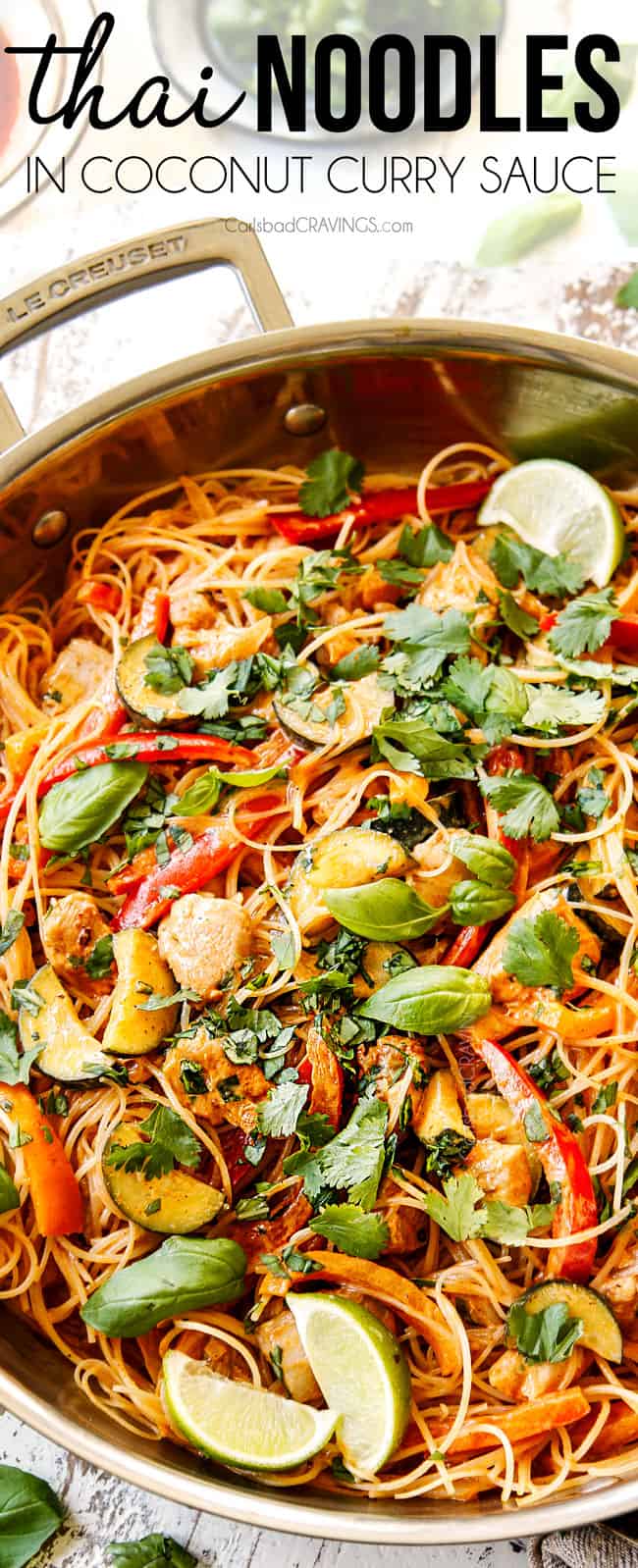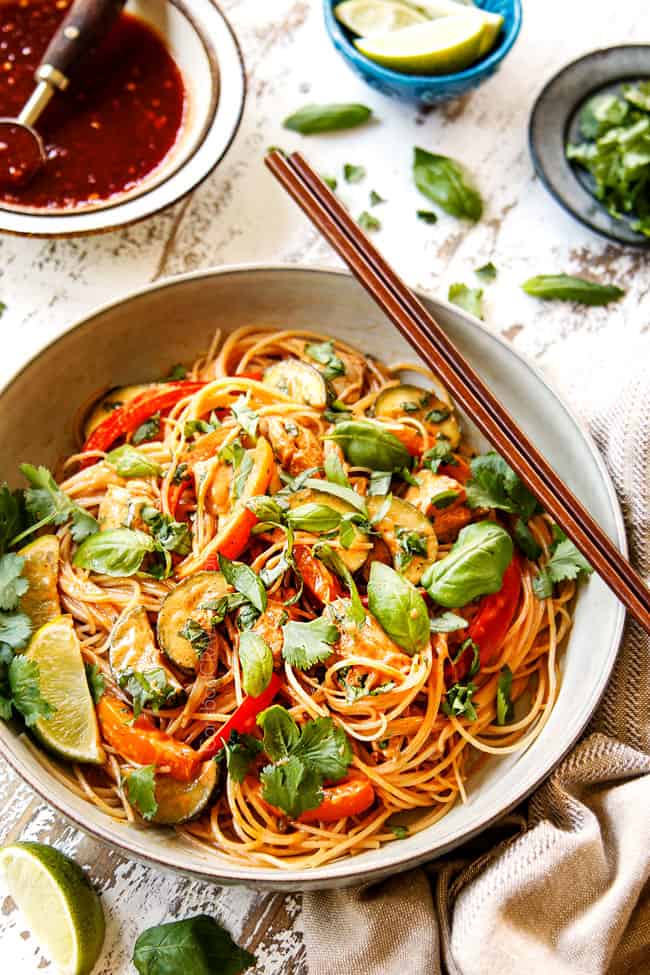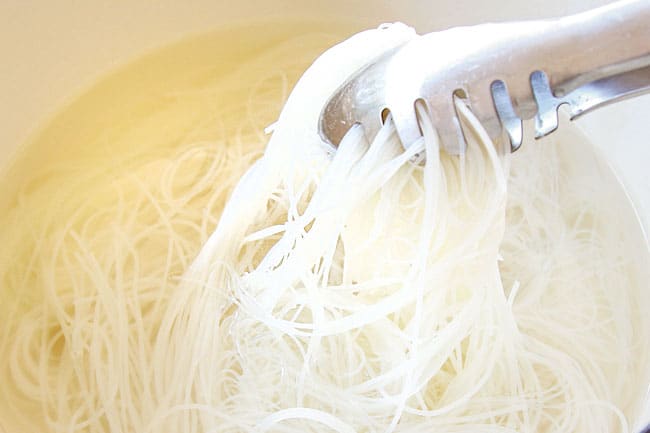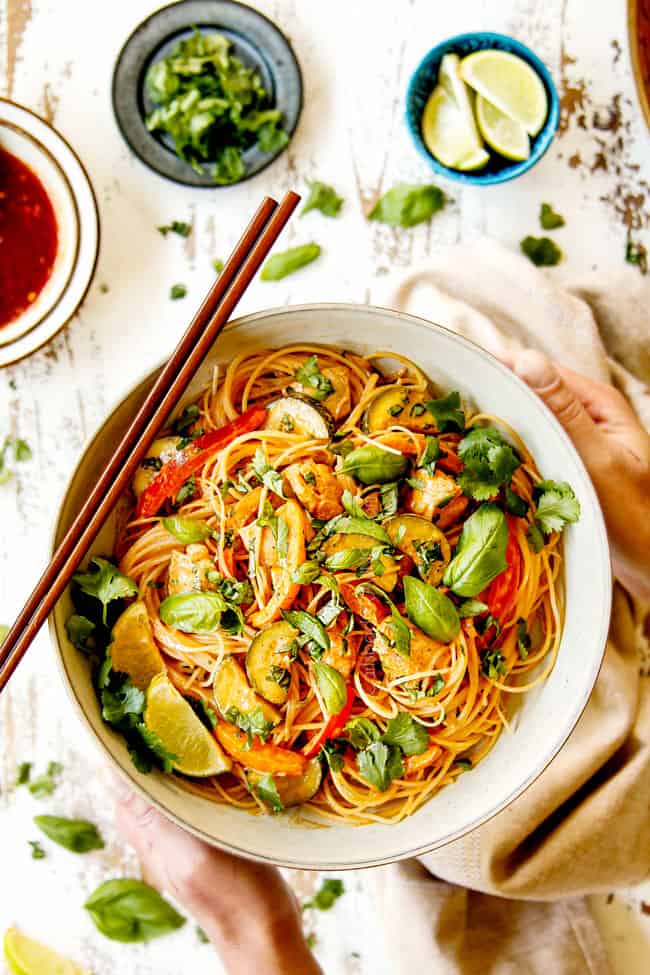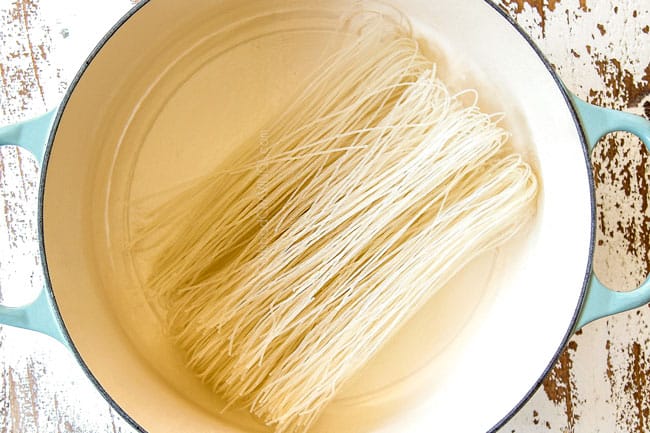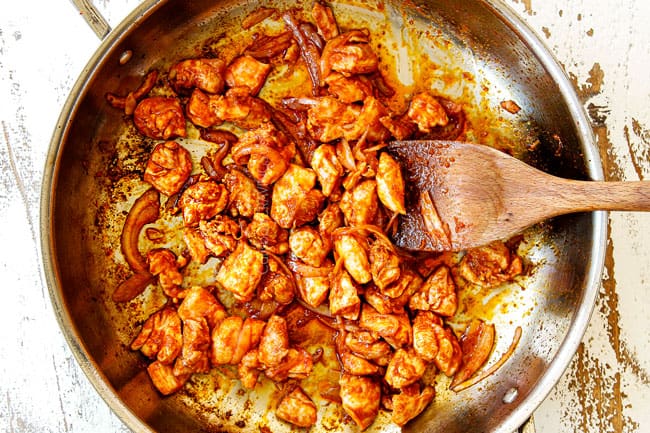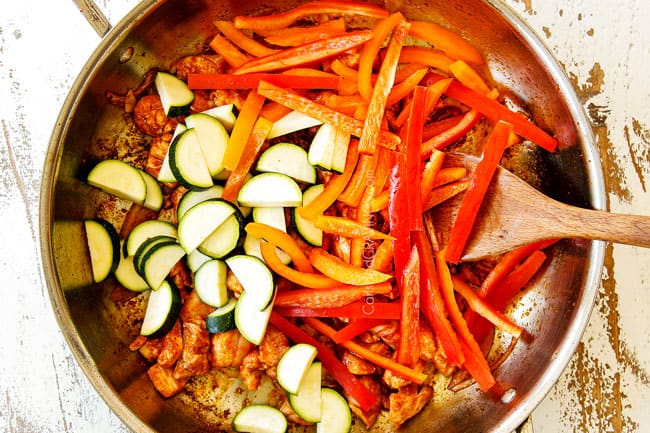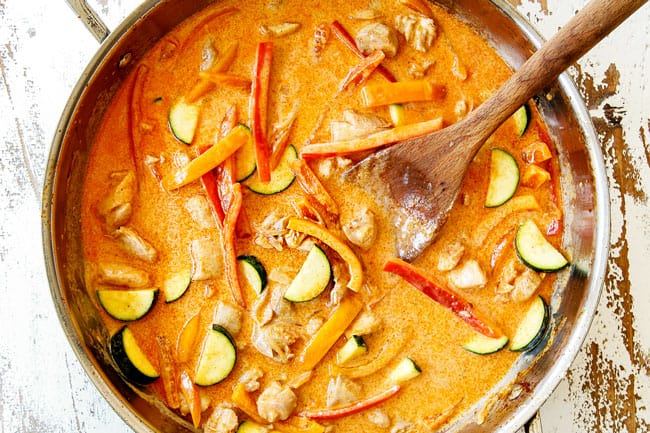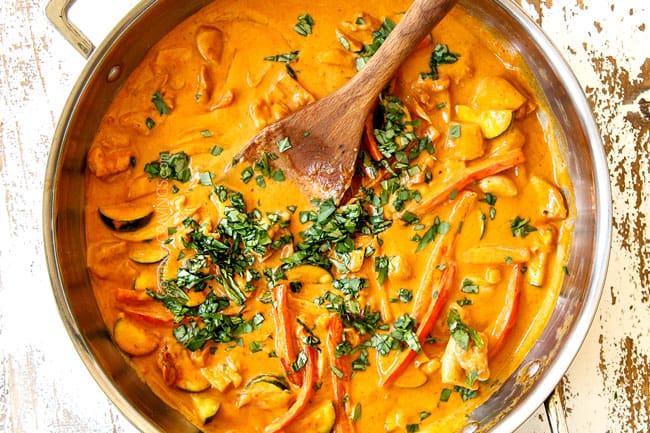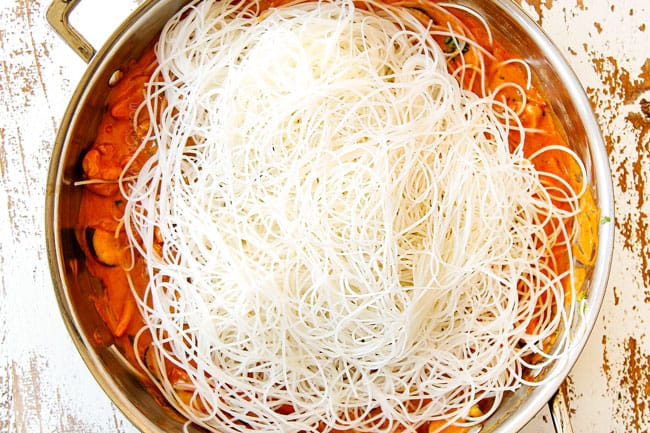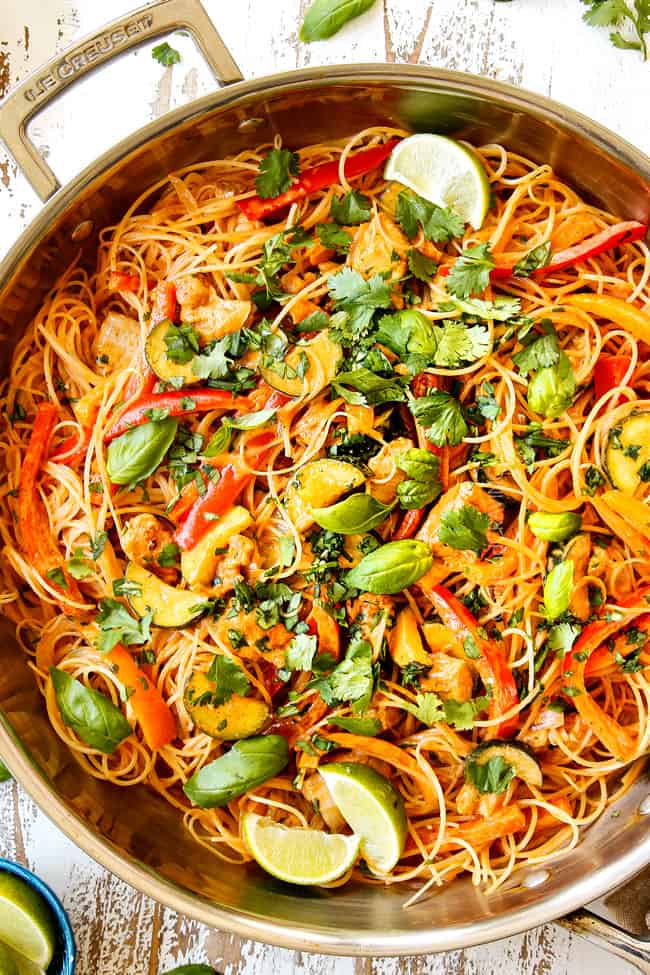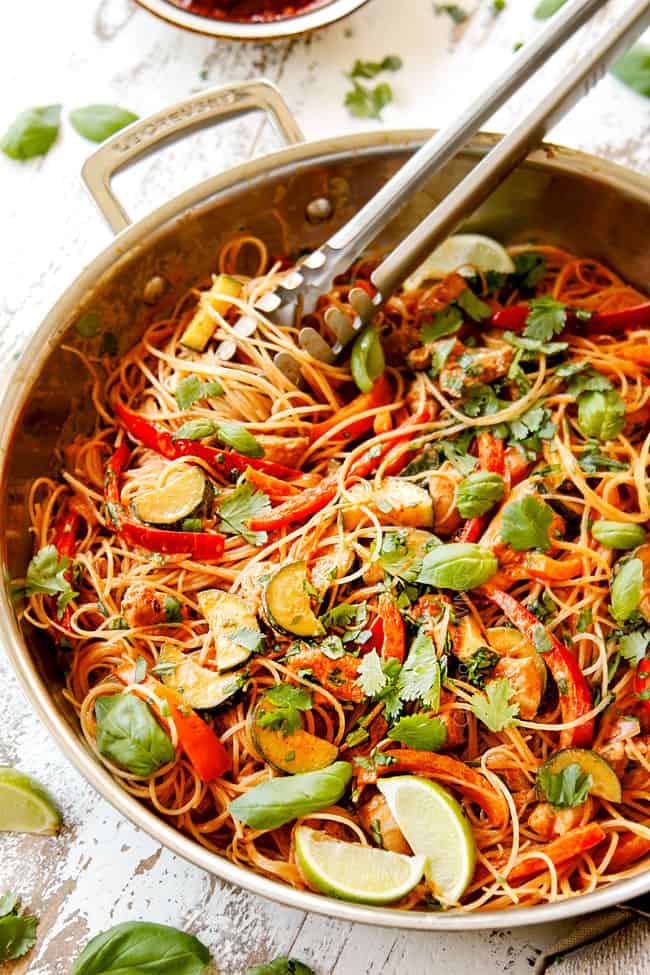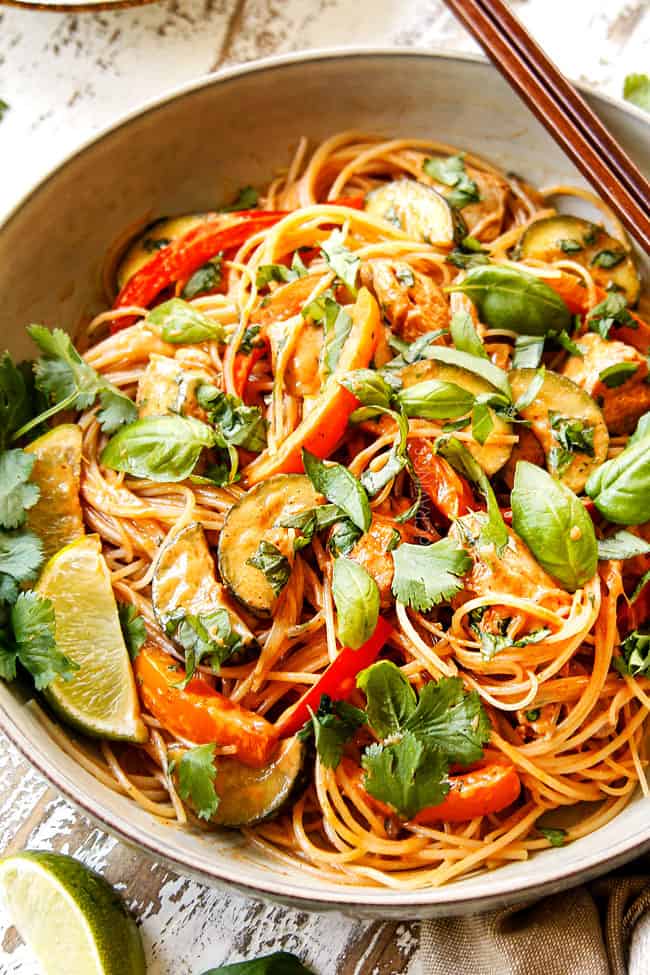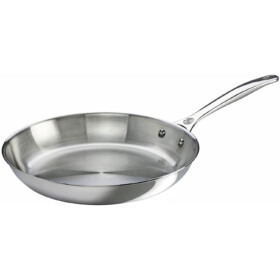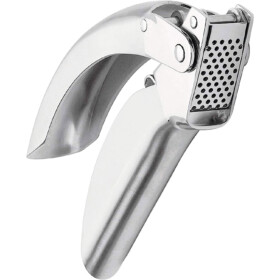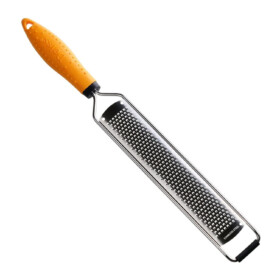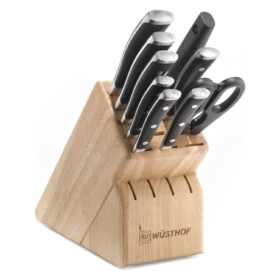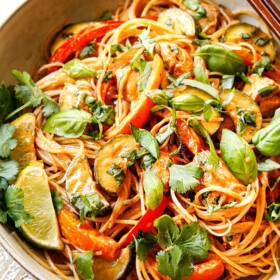PIN THIS RECIPE TO SAVE FOR LATER
RICE NOODLES RECIPE
This Rice Noodles recipe is easy to make at home with just a few helpful tips and tricks. In the sections below I’ve detailed how to choose the correct rice noodles, what pan to use, what curry to use etc., but first let me introduce you to the spectacular recipe. This Rice Noodles recipe is based off of my beloved red curry chicken recipe which is a readers favorite with hundreds of rave reviews. I’ve slightly adapted that sauce, added al dente rice noodles and this tasty one pot wonder was born. REASONS TO LOVE RICE NOODLES:
RESTAURANT delicious. This Rice Noodles recipe boasts a symphony of complex flavor with layers of satisfying texture – my two favorite culinary pleasures. They are creamy, crunchy, al dente, juicy, vibrant, savory, salty, mildly sweet, comforting with just the right kick of heat. Easy. I use the same rave-review formula of my red curry, green curry, yellow curry, panang curry, and coconut curry recipes by enhancing store-bought curry paste with aromatics, soy sauce, fish sauce, lime juice and brown sugar and the resulting curry tastes like it’s been simmering for hours but only takes minutes! Quick. Soak your noodles, chop your veggies, chop your chicken then it’s less than 15 minutes of cooking! It’s a somewhat long list of ingredients, but most of them you are just dumping into the sauce. Pantry friendly. You can find all the Rice Noodles recipe ingredients at any grocery store which means you can keep them stocked and make these rice noodles any time a craving strikes. Versatile. Swap the chicken for shrimp, pork or beef, use whatever veggies you have on hand and/or add more or less heat. Customizable heat: These Rice Noodles use red curry paste as the fragrant base but you can customize the heat by adding Asian chili sauce to taste. Less expensive. Serve the whole family for the price of dining out! Prep ahead. You can prep all of the meal ahead of time: chop the chicken, chop the veggies, whisk your sauce and soak your noodles; now you’re just a quick simmer to dinner. One skillet. Aside from the bowl for the rice noodles, this Rice Noodles recipe is a one skillet dinner – the chicken, veggies, and sauce all cook in one pan which means hardly any cleanup! Meal-in-one. You can skip the laborious sides because these Rice Noodles are packed with protein, veggies and noodles for a complete meal-in-one all cooked in one skillet. Great leftovers. The rice noodles reheat beautifully for fantastic leftovers!
WHAT DO RICE NOODLES TASTE LIKE?
This Rice Noodles recipe has it all. It’s lusciously creamy due to the coconut milk (and my secret trick), boldy flavored due to the red curry paste and adeptly balanced between savory, salty, sweet and sour. Each and every bite is a hypnotic slurp that will have you coming back for more.
Red curry paste: infuses the rice noodles with a wonderfully complex spectrum of savory, sweet, spicy, deep earthy flavor from its broad range of ingredients such as red chiles, crushed garlic, lemongrass, shallots, and ginger. Aromatics: ginger adds a warm, spicy, sharp peppery taste, shallots a mild sweetness and garlic adds a pungent, herby, warm aromatic flair. Sauce: is savory, slightly sweet, coconut-y and as spicy as you want it made from coconut milk, soy sauce, fish sauce, brown sugar, lime juice and brown sugar.
WHAT ARE RICE NOODLES?
This Rice Noodles recipe uses rice vermicelli, known as bí-hún (literally “rice vermicelli”). Rice vermicelli are a very thin form of rice noodles, like linguine, sometimes simply referred to as rice noodles, thin rice noodles or rice sticks.
What are rice noodles made out of?
Rice noodles are made out of rice flour and water, and occasionally small amounts of tapioca or cornstarch as well. This means they are gluten-free, fat free, and vegan.
What is the texture of rice nboodles?
Rice noodles are one of my favorite noodles to use because they maintain their perfectly al dente texture for days, if not overcooked initially, making them perfect leftovers. They are delightfully chewy, light, springy and absorb a ton of flavor while still remaining al dente. I also use them in my Singapore Noodles and Thai Chicken Noodle Soup (an all-time readers favorite) so don’t worry about purchasing a large package because they will get used up!
WHERE CAN I BUY RICE Noodles?
WHAT CAN I USE INSTEAD OF RICE NOODLES?
You should be able to pick up rice noodles at your grocery store, but if you need to make this Rice Noodles recipe, NOW (I get you), then the next best thing is linguine. Linguine is similar in size but it doesn’t offer that delightful chewy texture and is prone to overcooking because it is so thin – so make sure you cook the pasta al dente as it will continue to cook when tossed in the sauce.
HOW DO I COOK RICE NOODLES?
Rice Vermicelli is so thin that it doesn’t need – and shouldn’t – be boiled. Instead, add the rice noodles to a bowl and cover with very hot water (microwaved or boiled). The soaking duration will depend on just how hot your water is, so I suggest checking the noodles at the early end of the soaking window suggested by your package instructions, for me that was 10 minutes. You want the rice noodles to be pliable but al dente. Take care to rinse and drain the rice noodles in cold water so they don’t continue to cook. You can use a colander or spin them dry in a salad spinner. If you aren’t ready to use them immediately, then toss them with a teaspoon of sesame oil to keep them from sticking together.
What are rice noodles for?
Once you have your package of rice noodles, there are so many ways to use them! They are fabulous inside spring roles, soups, stir fries and even salads. They add wonderful texture while letting the flavor of the other ingredients shine.
RICE NOODLES RECIPE INGREDIENTS
FOR THE CHICKEN:
You can use either chicken thighs or chicken breasts but I suggest chicken thighs for the juiciest results because we are not marinating the chicken.
Boneless skinless chicken thighs: are dark meat and therefore inherently juicier and hard to overcook. Thighs are the best option for maximum flavor and tenderness. Boneless skinless chicken breasts: are leaner than chicken thighs but still will work, just take care not to overcook. Rotisserie chicken and leftover chicken: to use leftover chicken, add the cooked chicken to the sauce with the bell peppers to heat through.
FOR THE SAUCE:
The sauce for these Rice Noodles is coconut milk-based that’s irresistible savory, salty and tangy with a balancing sweetness. The ingredient list might look long, but it is made with a quick whisking of pantry staples (for anyone who does much Asian cooking). If you don’t own any of the following ingredients, I promise you will get a TON of use out of them if you make any of my other Asian recipes. Here’s what you’ll need:
FOR THE AROMATICS:
While the veggies are flexible in this Rice Noodles recipe, the aromatics are NON-NEGOTIABLE. They are the quintessential ingredients to any good curry and provide the flavor base in which all other flavors are built upon.
Aromatics: shallots, ginger and garlic elevate the flavor profile. You can use more or less of any of the aromatics to suite your tastes. If you are feeling extra lazy, you can substitute the fresh ingredients with powders. The typical rule of thumb is 3:1, so one part dried to three parts fresh. Thai Basil: tastes like Italian basil with slightly savory, spicy, anise-like notes. If can’t locate Thai basil, Italian basil still tastes great in this recipe. You may also substitute with 1 ½ teaspoons dried basil. Garlic pro tip: purchase the pre-bagged, already peeled garlic to save time. They are actually less expensive than whole garlic cloves (at least when I did the math). Ginger pro tip: I like to freeze ginger so it’s always at my fingertips. To freeze ginger: grate it, spread it by the teaspoon or tablespoon on parchment paper and flash freeze until solid, about 1 hour. Transfer to an airtight container or plastic bag for up to 6 months. You can add frozen ginger directly to your Rice Noodles.
FOR THE VEGETABLES:
These Rice Noodles are a blank canvas when it comes to veggies. I kept it simple and used:
Bell pepper: you can use two bell peppers. You’ll want to stick with red, yellow or orange bell peppers or a combination because they are sweeter than green. Zucchini: adds a fresh, satisfying crunch. Zucchini cooks very quickly so chop it on the thicker side so it doesn’t become soggy.
Rice Noodles Recipe Ingredient Facts
CAN I USE SHRIMP?
Absolutely! This Rice Noodles recipe is also delicious with shrimp instead of chicken but you will want to cook it differently. Instead of adding the shrimp with the curry paste, cook it on its own with some oil just until opaque and cooked through. Remove to a plate and add to the sauce at the end of cooking.
CAN I MAKE THIS VEGETARIAN?
Absolutely! Swap the chicken with firm tofu or chickpeas or omit it altogether.
DO I HAVE TO USE FULL-FAT COCONUT MILK?
I don’t insist on full fat coconut milk but I HIGHLY suggest it if you would like restaurant-style creamy, flavorful Rice Noodles. Light coconut milk simply isn’t as thick or flavorful so you’re missing out on both flavor and texture. If you do use light coconut milk, I suggest adding an additional ½-1 tablespoons cornstarch to help thicken it up.
DO I HAVE TO ADD CORNSTARCH?
My authentically blasphemous key to gorgeously, thick, silky coconut sauce is to whisk quality coconut milk (I like Chaokoh) with a little cornstarch. The end result is a rich, luscious red curry coconut sauce that is SO creamy, so infused with flavor all cradling your tender chicken, crisp-tender vegetables and chewy rice noodles. If you are opposed to cornstarch, you can certainly omit it but your sauce won’t be as lusciously thick and creamy.
WHERE CAN I FIND RED CURRY PASTE?
Red Paste is much easier to find than yellow curry paste. It should be easy to find in the Asian section of your grocery store. I find Thai Kitchens Green Curry paste to be the most common and is what I used in this recipe. While, I wouldn’t say it’s the best curry paste, it gets the job done, especially because we are going to be elevating it with additional aromatics.
CAN I USE ITALIAN BASIL INSTEAD OF THAI BASIL?
Yes! Remember when I said this Rice Noodles recipe is pantry friendly? That is because you are welcome to substitute Thai basil with Italian basil because Thai basil is already in the curry paste and there are other strong flavors going on. Of course, Thai basil is preferred, but isn’t necessary. I find Thai basil is worth seeking out when less ingredients are used such as Vietnamese spring rolls, in which the flavor is a key element but Italian basil is perfectly acceptable in this recipe.
CAN I USE OTHER VEGETABLES?
Absolutely! You can mix and match the veggies based on what’s in your fridge, your favorites, what’s in season or what’s on sale, but the important thing to remember is we want some crunch to offset the chewy noodles. To accomplish this, select a few types of veggies and DON’T overcook! Here are other veggies you can try:
Broccoli Cauliflower Celery Asparagus Baby corn Edamame Bean sprouts Cabbage (green or red) Carrots
IS THIS RICE NOODLES RECIPE GLUTEN FREE?
As written, this Rice Noodles recipe is not gluten free – but almost! The rice noodles are gluten free because they are made from rice flour (not wheat flour), but you will need to replace the soy sauce with gluten free soy sauce or tamari. You will also want to double check that your curry paste and fish sauce are gluten free (they usually are). The rest of the ingredients are gluten free.
WHAT ELSE CAN I ADD TO RICE NOODLES?
These Rice Noodles don’t have to be limited to just protein and veggies. You can also add:
Nuts: peanuts or cashews add a deeply satisfying crunch. Take care to purchase raw, unsalted nuts. To elevate your cashews or peanuts, dry roast them in a nonstick skillet until toasted- YUM! Water chestnuts: also add a tantalizing crunch. Water chestnuts are easy to find in a can so you can keep them stocked and ready to go. Sesame seeds: add the nutty sesame flavor. Take care to use toasted sesame seeds or toast them yourself.
HOW TO MAKE RICE NOODLES RECIPE
This Rice Noodles recipe is very simple even though the ingredient list might seem lengthy. It starts by soaking the rice noodles in hot water to soften them up. You can do this while you’re chopping the rest of your ingredients. We build our flavors in the same pan by first sautéing our red curry, chicken and shallots then adding the garlic, ginger, and veggies. Finally, we add the coconut milk and remaining sauce ingredients and simmer just a couple minutes to thicken into unabashedly flavorful, texture-packed rice noodles!
Here’s a step by step guide How to make Rice Noodles:
Soak rice noodles. Place rice vermicelli noodles in a large bowl and cover with hot boiling water. Soak per package instructions just until al dente, drain, rinse in cold water; set aside. Toss with a drizzle of sesame oil if not using immediately. Bloom the curry. The key to unlocking the full flavor of red curry paste is to bloom the curry. This is essentially toasting the curry in oil which helps the flavor emerge or “bloom” – and it makes a HUGE difference. We also cook the curry with the chicken and shallots which laces them with curry goodness. Have you ever had chicken in a curry that is bland? Well, they have definitely skipped this step and just boiled the chicken in the sauce as an afterthought. Sauté vegetables and aromatics. Next, add the bell peppers, zucchini, ginger and garlic, and sauté for 1 minute. This develops the ginger and garlic flavor but more importantly allows the curry to permeate all of the ingredients before we add the coconut milk. Add coconut milk. Next, stir in half of the coconut milk. Whisk the remaining half of coconut milk with a little cornstarch and add it to the skillet. While cornstarch definitely isn’t authentic in coconut sauces, it is a fabulous trick I’ve discovered and use in all of my curry recipes to create a creamier coconut sauce – it will BLOW YOUR MIND how creamy it gets! Dump in all the remaining ingredients except the basil and simmer for 5 minutes or until the sauce thickens and the vegetables reach desired crisp-tenderness. Stir in basil. Stir in fresh basil and garnish with cilantro, lime zest, lime juice and chili sauce to taste. Add rice noodles. Add rice noodles to coconut curry sauce.
TIPS AND TRICKS FOR RICE NOODLES RECIPE
Here are is a summary of some tips and tricks to ensure you achieve the best Rice Noodles recipe every time:
Not all red curry paste is created equal. Red curry pastes differ in spice level by brand. If using more mild Thai Kitchen, then I would start with 3 tablespoons; if using spicier Mae Ploy, you may want to start with 2 tablespoons or even 1 tablespoon if you are sensitive to heat. Prep. These Rice Noodles come together very quickly once you start cooking, so you will want all of the aromatics and vegetables chopped before you start cooking. Customize. Feel to customize the protein and veggies with your favorites. Use a large saucepan. A large saucepan is ideal so you can make the entire dish in one pan without rice noodles flying everywhere. Don’t overcook rice noodles. I recommend testing your noodles 2 minutes before the package recommends because you can’t undo sad, soggy noodles. Stop rice noodles from cooking. If your noodles are done before your sauce is ready to receive them, rinse them in cool water to prevent them from continuing to cook. Don’t worry about the noodles being cold because the sauce will warm it right up once combined. Prevent rice noodles from clumping. If you’re not using the noodles right away, toss them with a little sesame oil to prevent them from sticking together. Use quality coconut milk. Set yourself up for success by using full-fat Chaokoh coconut milk. It is 100X creamier than any other brand and mega flavorful. Don’t overcook veggies. Don’t be tempted to cook the vegetables longer than instructed. They cook very quickly and will continue to cook in the sauce once removed from the heat. Adjust to taste. Make this Rice Noodles recipe perfect for YOU! Make it more tangy, less tangy, sweeter, less sweet, saltier, less salty, spicier, less spicy, etc.
WHAT PAN IS BEST FOR RICE NOODLES?
I suggest a large saucepan that’s large enough to hold all of your ingredients including your rice noodles. I love my stainless steel saucepan as it’s virtually indestructible, distributes heat evenly, and won’t leech into the food. It is particularly useful when cooking with acidic ingredients like tomatoes, vinegars, lemon or lime juice because the metal won’t react with the acidity. I love both my 10 and 12-inch Le Creuset Stainless Steel Pans and used my 12-inch for this Rice Noodles Recipe. This more economical pan also has excellent reviews.
RICE NOODLE RECIPE VARIATIONS
As previously discussed, you can customize this Rice Noodles recipe by swapping the vegetables for your favorites or what you have on hand. You can also make these Rice Noodles with shrimp, pork or tofu instead of chicken. You can also customize the flavor of these Rice Noodles:
Want sweeter rice noodles? Add more brown sugar Want saltier rice noodles? Add more fish sauce or soy sauce Want tangier rice noodles? Add more lime juice Want spicier noodles? Add more Asian chili sauce Want thinner noodles? Add more coconut milk Want more crunch? Add cashews, peanuts, or water chestnuts
HOW SPICY ARE THESE RICE NOODLES?
These Rice Noodles are extremely flavorful but only as spicy as you want them based on the amount of chili sauce you add. That being said, red curry pastes differ in spice level by brand. Brands like Thai Kitchen tend to be less spicy. Brands like Mae Ploy tend to be spicier. If using Thai Kitchen, then I would start with 3 tablespoons. If using Mae Ploy, you may want to start with 2 tablespoons or even 1 tablespoon if you are sensitive to heat. You can add more red curry to the sauce once it’s simmering or chili sauce to taste at the end of cooking.
CAN I PREPARE RICE NOODLES AHEAD OF TIME?
In this Rice Noodles recipe, the prep work takes more time than the actual cooking – but is SO worth every second! In addition, all the prep can be done ahead of time which makes this a great recipe for weeknights or for entertaining. Once the prep is done, these Rice Noodles literally come together in minutes. To prep ahead:
Noodles. Soak the noodles, rinse and drain, then toss with a drizzle of sesame oil. Store in an airtight container/plastic bag in the refrigerator for up to one week. Chicken. Trim and chop the chicken and store in a plastic bag in the refrigerator. Sauce. Whisk the sauce ingredients together and store it in an airtight container in the refrigerator. Veggies. Chop the veggies, basil, garlic and ginger and store in separate baggies/containers in the refrigerator. Cook! Within the next 48 hours, proceed with the recipe as outlined.
HOW LONG ARE RICE NOODLES GOOD FOR?
Rice Noodles should be stored in an airtight container in the refrigerator. When properly stored, they are good for up to four days.
HOW DO I REHEAT RICE NOODLES?
This Rice Noodles recipe reheats well so you can enjoy leftovers for days! Just take care to cook the noodles al dente initially.
Microwave: Transfer servings to a microwave-safe plate and cook for one minute, stir, then continue to heat at 30 second intervals until warmed through. Stove: For larger portions, reheat noodles gently over medium-low heat in a large skillet until warmed through.
CAN I FREEZE RICE NOODLES?
No, rice vermicelli does not freeze well and will disintegrate when thawed.
WHAT DO YOU EAT WITH RICE NOODLES?
These Rice Noodles are a meal-in-one complete with protein, veggies and starch, so they really don’t need much – if anything – to flush out the meal. Still, that doesn’t mean they aren’t still delicious with:
Appetizers: transform Rice Noodles into a feast complete with appetizer such as Chicken Lettuce Wraps, Pineapple Cream Cheese Wontons, Crab Rangoons, Chicken Satay, Pork Egg Rolls, Sesame Chicken Egg Rolls, Sweet and Sour Chicken Egg Rolls, Chinese Chicken Wings or Potstickers. Soup: let the Asian feast continue with soup! I love to warm up to Egg Drop Soup which is SUPER easy and always silky, satisfying favorite. Other favorite Asian Soups include Wonton Soup, Ramen, Laksa, Miso Soup, Thai Soup with Wild Rice. Salad: this Rice Noodles recipe already boasts veggies so a salad isn’t really necessary, but still delicious. Some of our favorite Asian inspired salads include Crunchy Asian Salad, Chinese Salad, and Asian Pineapple Salad. Fruit: fresh fruit such as chopped pineapple is always an easy, welcome refreshing side. We also love Rice noodles with Grilled Pineapple, Summer Fruit Salad, Perfect Fruit Salad, Creamy Grape Salad, and Pina Colada Fruit Salad.
LOOKING FOR MORE ASIAN TAKEOUT FAVORITES?
Sweet and Sour Chicken Orange Chicken Sesame Chicken Szechuan Chicken or Szechuan Beef General Tso’s Chicken Hoisin Chicken Stir Fry
Helpful Tools to Make Rice Noodles
Large Saucepan: if you don’t have a wok, then a large stainless-steel saucepan is the perfect alternative for curries, stir fries and I also LOVE it for pastas! They are virtually indestructible, distribute heat evenly, don’t react with acidic ingredients and won’t leech into the food. I love both my 10 and 12-inch Le Creuset Stainless Steel Pans but this more economical pan also has excellent reviews. Garlic press: I use this every single day! It is the ultimate garlic press- it is easy-to-use, easy-to-clean and minces garlic with one squeeze. Unlike other presses, this garlic press has beveled holes that finely cut the clove rather than bruising it, bringing out the best flavor. Zester/micro planer: cooking is made 100X easier when you have the right tools for the job! This zester is razor-sharp and makes grating everything a snap from ginger, lemons, limes, Parmesan, nutmeg and chocolate. Quality Knives: a chef’s knife will be your most used kitchen tool by far! Quality knives make prep time much quicker and are important for safety as well. If you’re concerned about moola, please remember that your best chef knives, depending on how hard you use them and how well you take care of them, can easily last 25 years or more. I love my Wusthof but there are hundreds of less expensive knives with great reviews such as this one.
Want to try this Rice Noodles RECIPE?
Pin it to your Dinner, Asian or Noodles Board to SAVE for later!
Find me on Pinterest for more great recipes! I am always pinning :)!
©Carlsbad Cravings by CarlsbadCravings.com Carlsbad Cravings© Original Tag @CarlsbadCravings and Use #CarlsbadCravngs Leave a Review, I Always Love Hearing From You!
